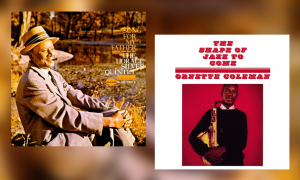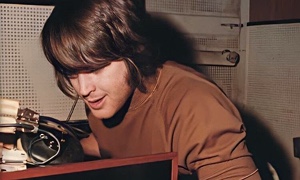Home » Jazz Articles » Building a Jazz Library » The Essential Satoko Fujii, Part One: Solo, Duo, Trio, Q...
The Essential Satoko Fujii, Part One: Solo, Duo, Trio, Quartet and Orchestra
I love any sound, including noise and also silence. I would use any sound and silence to make music. I don't want to limit myself.
—Satoko Fujii
 Satoko Fujii
Satoko Fujii Solo
Libra Records
2018
"Contemplative" is a word that comes to mind on the first spin of Solo. Considering Fujii's extensive discography, that's not always the case. Her orchestral outings (Nagoya, Tokyo, New York, Berlin) can sound cataclysmic and chaotic—though it's a chaos that often gels into serene beauty, spiced with lilting melodic interludes. Her group Kaze: get too close to the speakers and it can burn off your eyebrows and take the enamel off your teeth.
As the music plays out on Solo, the relatively straightforward beauty and allure intersects with the burstings of breaking glass, the culminations of gathering momentums. An oddly flattened, percussive left hand bumps in with a beat that sounds like a resonant pulse.
Fujii's discography is too vast and varied for the tagging of it with a "signature sound." Solo, more so than her other solo affairs— Sketches (Libra Records, 2004), Invisible Hand (Cortez Sound, 2016), or any of her numerous ensembles for that matter—deals in beauty, delicacy of touch, graceful melodicism.
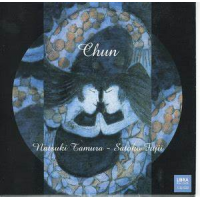 Natsuki Tamura / Satoko Fujii
Natsuki Tamura / Satoko FujiiChun
Libra Records
2008
Fujii is especially adept in the duo format, most notably in her recordings with trumpeter Natsuki Tamura, her longtime musical partner, and also her husband. With Chun—Fujii at the piano and Tamura with his horn—anything goes, in conversations that roam all over the place in spirited give and takes. Madcap Keystone Cops soundtracks shift into pensive interludes laid down with a stately deliberation that, in a heartbeat, crank up to warp speed, spewing new ideas at an unrelenting pace. A sense of freedom and improvisation pervades. Currently, Fujii and Tamura are making recordings in their small apartment in Kobe, Japan, and the convenience of the home studio, with two musicians under one roof has moved them into the making of more duo sets. This is a good thing.
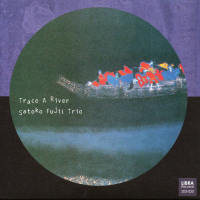 Satoko Fujii Trio
Satoko Fujii Trio Trace A River
Libra Records
2006
Trace A River is Fujii's seventh trio recording with this particular line-up—Mark Dresser on bass and Jim Black in the drummer's chair, with Fujii at the piano. It is perhaps their best, though that, of course, could be argued. The piano trio format is, in Fujii's hands, unconventional. The unexpected lurks around every corner. Brashness and aggression mix it up with spaciousness and reverie, and sometimes pure noise. Fujii periodically explodes, making crystalline sounds, like those of a small animal that has leapt into the chandelier, in a high panic from the cat that was on its tail. Equality of input from the individual trio players is taken to the highest level, sometimes sounding more like a fight for dominance than a musical endeavor.
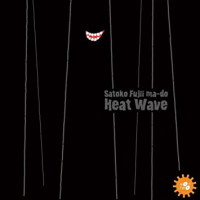 Satoko Fujii Ma-Do
Satoko Fujii Ma-Do Heat Wave
Not Two Records
2008
An incident that reveals something of the character of Satoko Fujii: On August 31, 2008, Satoko Fujii and her Ma-Do quartet played a show in San Diego, at the old Fifth Avenue Dizzy's venue. Fujii and Ma-Do had recently released Heatwave . Mid-show, Fujii paused to address the audience, holding up the CD cover for the disc, that had a completely different color scheme than the for-sale album. Smiling, she said that the art on our albums was a mistake, that it was planned to look like the one she held in her hand. "It was a wrong, but I liked it," she explained, beaming, "So here it is," she continued, holding up the "mistake." for all to see.
In Fujii's musical world, maybe there are no mistakes. Heatwave, a piano/bass/drums/ trumpet affair, detonates on its eponymous opening number. The sound thereafter is by turns clamorous, brittle, loud, and seismic, and weird, an intricate weave of virtuosic muscularities. It finds unexpected grooves; moments of exquisite reverie blossom—this is Satoko Fujii at her heavy metal best. If mistakes were made, they were embraced.
 Satoko Fujii Orchestra New York
Satoko Fujii Orchestra New York Fukushima
Libra Records
2016
In 2011, an earthquake set into motion the events that would create partial meltdown of fuel rods in the reactors in a nuclear power plant in Fukushima, Japan. Radiation was released. The effects are still felt, and will be for decades (at least)—an especially troubling situation for the only country to have experienced the initially catastrophic and ultimately corrosive and malignant aftermath of a nuclear attack.
Satoko Fujii had something to say about this, with her CD release of Fukushima. This five-part, hour-long personal contemplation of the disaster—shaped by Fujii and her Orchestra New York—breathes into existence with "Part 1," a just-above perception breeze, human breath, blowing through the horns, a wafting of most essential and immediate necessity for the maintenance of life. Or maybe it signifies an ill wind.
This sprawling symphony of sorts travels in a sometimes subdued manner over ominous terrain. The very electric guitar of Nels Cline— in his first recorded appearance in the Orchestra New York—creates searing but almost under-the-radar emissions of ionized radiation, knocking electrons off of the ambient atomic materials in its path. Horns enter—sometimes they rage, sometimes they fall to their knees in anguish, or howl with pain, or soak in sorrow. The thirteen piece ensemble—three reeds and six brass, along with bass/guitar/drums rhythm team—breaks into smaller units, then swells into majestic plumes of virulent harmonies, or sharp spikes of tainted atomic material. In "Part 4," a stealthy subterranean moan lays a foundation for brash horn statements, labored breathing, and, ultimately, the chatter of distressed birds—canaries and sparrows engulfed in the invisible wash of deadly radiation. Then a powerful and relentless groove settles in, on one of Fujii's masterpieces.
Tags
Building a Jazz Library
Dan McClenaghan
Braithwaite & Katz Communications
Paul Bley
Natsuki Tamura
Mark Dresser
Jim Black
Satoko Fujii
Nels Cline
PREVIOUS / NEXT
Support All About Jazz
 All About Jazz has been a pillar of jazz since 1995, championing it as an art form and, more importantly, supporting the musicians who make it. Our enduring commitment has made "AAJ" one of the most culturally important websites of its kind, read by hundreds of thousands of fans, musicians and industry figures every month.
All About Jazz has been a pillar of jazz since 1995, championing it as an art form and, more importantly, supporting the musicians who make it. Our enduring commitment has made "AAJ" one of the most culturally important websites of its kind, read by hundreds of thousands of fans, musicians and industry figures every month.










